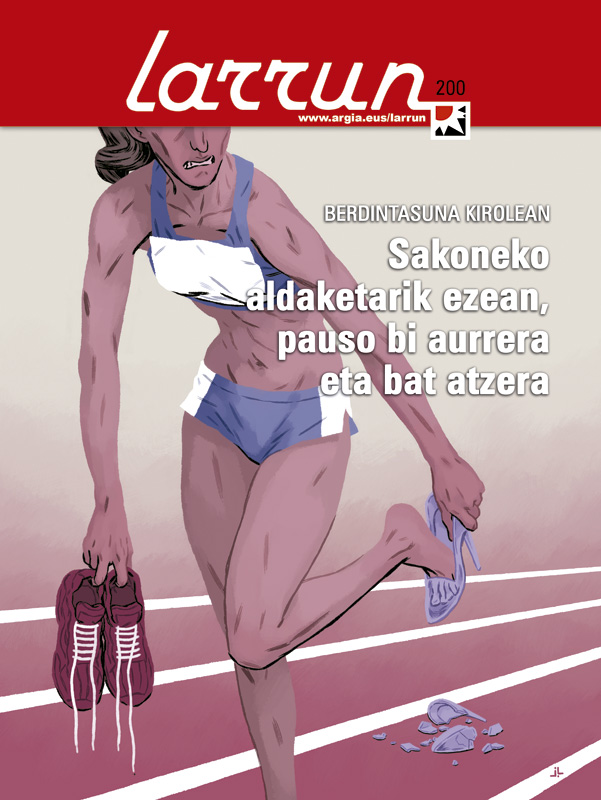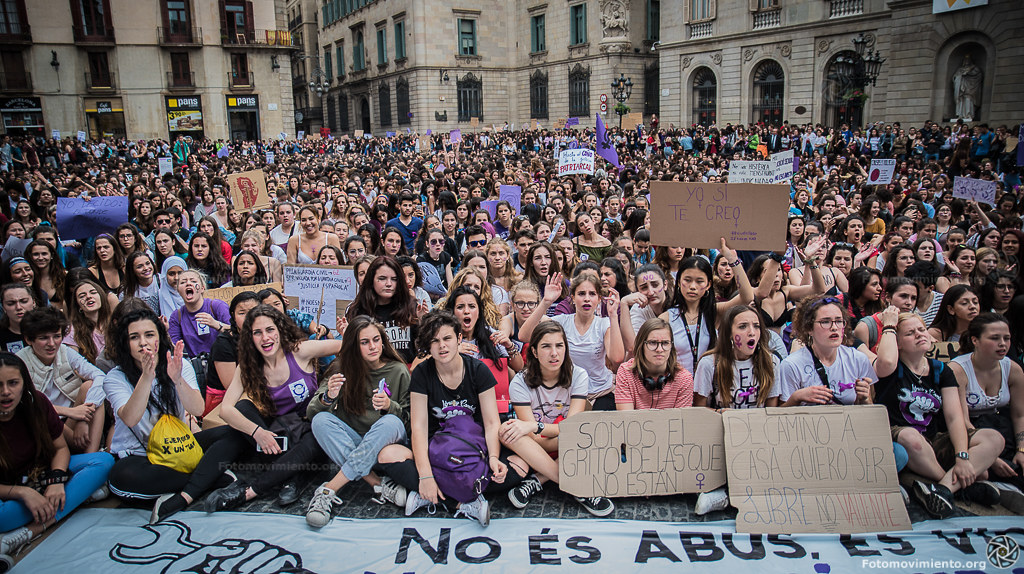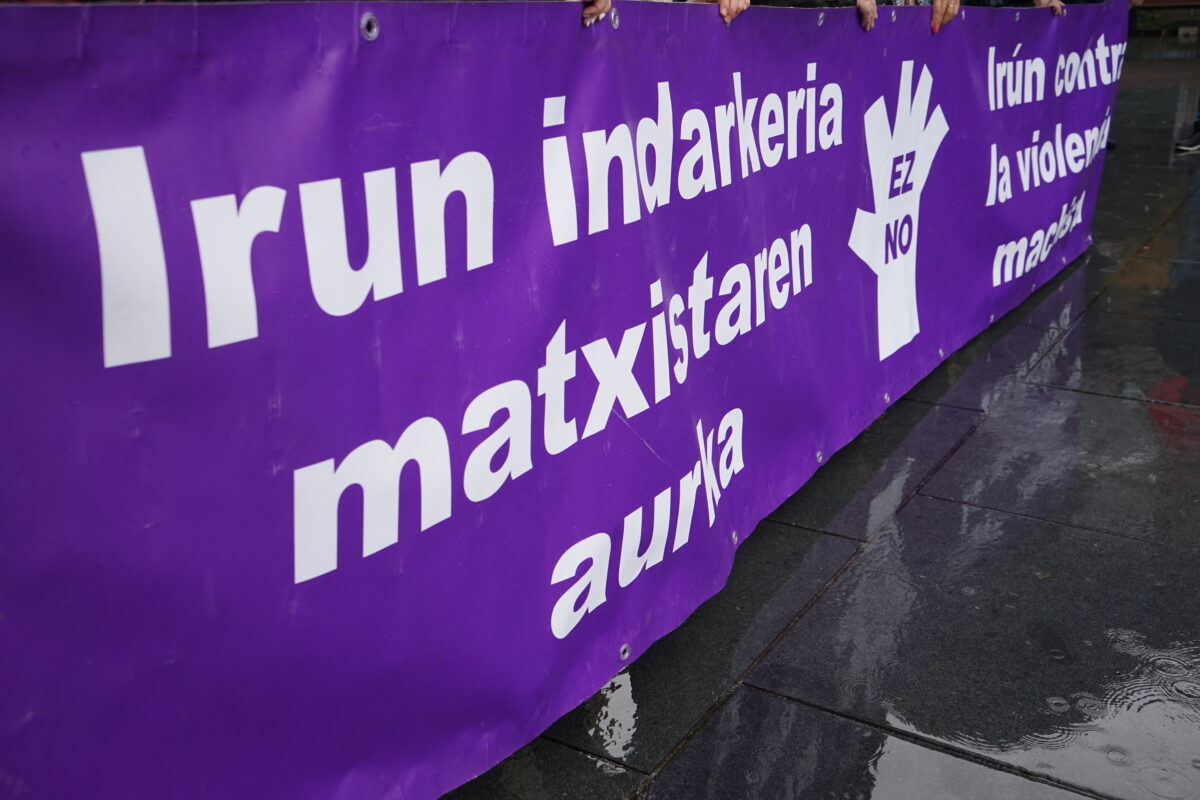"Federations and clubs should not see us as a threat, but as an opportunity"
- Ainhoa Azurmendi is an expert on equality issues. Member of consulting firm Avento, author of several guides to work the gender perspective in the sport and federated handball player until 2012. He played in Hernani, Fortuna, Octopus and Ereintza. Today it runs, on the mountain, on the pirate, on the shovel… It talks about the obstacles faced by women athletes, and emphasizes the structural problems.

He says that we should place the starting point of the debate at the time we are born.
Let me give you an example of what a father said to me. He said that when it rained, his daughter couldn't play handball, because she would get wet and stay in the cold. I told her that my son was playing football at the same time, and she said, “Yes, but it’s not the same.”
On the other hand, my friends tell me that it's rare for a woman to be alone on the mountain, with no friends. The reason is not that you don't like the mountain. Who doesn't like that sense of freedom, of swimming in the sea, of hacking, of running down the street, of enjoying space? All of this has to do with the socialization process. Traditionally, we've been educated in enclosed spaces and we've been more controlled. In addition, limits have been placed on the girls' body movement, which has not been injured. It is important to develop from small skills such as coordination, running, walking between rocks, paddling, playing with the ball... It is often said: “The boy needs this, he’s very moved!” Well, girls too! What happens is that through toys we are set limits. With the ball, psychomotor skills can be developed, but with the wrist… The same with clothing; for example, skirts hinder free movement.
Therefore, what is received from a young age is important for girls to stay in sport.
It is indeed important that sport should become a source of satisfaction. Much work remains to be done, resources must be made available to parents, teachers and other actors so that the motivation for sport among girls is greater. There are many people who are very conscious and each one is making a great effort in their field, but it is essential to socialise even more the tools we have.
It is often considered normal for girls to leave the sport at a certain age, as if it were something subjective. And it's not subjective. If a woman experiences pleasure doing sports and satisfies her body, she will seek those feelings throughout her life.
You mentioned our relationship with the body…
Shame, aesthetics, complexes -- they mix a lot of ingredients. The media, for example, incessantly repeat some beauty chants, which greatly influences the valuation of our body. If I’ve been playing sports since I was young, I’ve been in the locker rooms with other girls, I’ve known the different bodies and I’ve lived naturally the contact that the competition involves, will also influence later on in sports practice.
Many women have told me about shame. They imply that they are not free to do what they want. Some of you will tell me that in sports clubs you see a lot of girls. They're right, and it's good, but before we go, they're closed, controlled places. The ideal situation would be for these girls also to have the opportunity to do other things outside the sports club.
And don't they? What hinders them?
To say that girls have a lot of obstacles to doing sport doesn't mean that someone is wanting to annoy us. We talk more about the burden they carry on their back, the socialization process and the stereotypes of role: toys, dresses, demands and expectations towards both sexes, treatment of women in advertisements and media... It is true that steps have been taken, that the institutions have developed policies in favour of parity, that in rugby or rowing nice things have been seen, that our demands are more accepted in society and that more girls do sport. In any case, if we were to debate on the basis, whether or not equality is given in practice… We should not be too encouraged to talk about progress. Much work remains to be done on raising awareness and training; the legislation must be enforced and given the importance it deserves. And in order to bring about change, it is essential to have the will to do so.
With reference to the legislation, Law 4/2005 of the Basque Government for Equality contains a section dedicated to sport that details the measures that affect different levels (federative structure and electoral processes or the sport practice of young people of school age).
An article of the Equality Act states that public institutions cannot subsidize sports activities that discriminate against women. It is a very good tool, it provides a framework, but the truth is that, in general, there is not enough effort to control it; in addition, unlike the traffic law, the Law of Equality is not punitive… The administrations should more rigorously control the federative and/or communicative impact on the implementation or communication of their budgets, apply measures to exclude sexist language and develop participation programs… However, study it. Some federations and clubs have taken steps, but these are uncoordinated steps, there are no joint bets. There is a lack of basic training, general planning, knowing what and how to apply it. Structural changes are essential. Federations and associations should not regard it as a threat, but as an opportunity.
Speaking of federations, Dorleta Ugalde, responsible for the equality programs of the Sports Directorate of the Basque Government, in an interview in Argia said that in the last ten years the licenses of the sports federations have not increased among women, which remain 20% of the total, but the girls have joined the sport in other ways: gyms, sports, by their own, by groups…
As a young person, we often hear that girls don't like to play sports. What happens is that maybe what they don't like is the style that's in some concrete structures, or the treatment that they get. How many times have we heard that we are not competitive? This is not the case. There are girls who are more competitive than others, just like boys. This repetition of stereotypes…
It is important to have a general approach, not only federations or clubs; in general, to take into account the gender perspective when making sports policy is fundamental. It is necessary to make planning and programming from a gender perspective – to set competition dates taking into account the needs of women and men, for example, changing rooms and toilets for women in the premises – to take account of the impact of budgets on women and men to avoid inequalities, to establish mechanisms to promote parity in decision-making bodies and to adapt meeting times to the needs of all members, to systematically designate the same number of judges for competitions, etc.
Not being in the resume doesn’t mean you don’t work…
It is true that there are people who are doing a great deal of work in this area, that the government has put in place several plans… but it is essential to get into the curricula, because there is a lack of resources – knowledge – also in Physical and Primary Education.
EAEko 47 kirol federazioen artean, bakarrak du emakumezko presidentea, golfekoak. Federazio-lizentzietatik %22 inguru dira emakumeenak.
Gizonen %45,5ek eta emakumeen %16,6k beste talde baten aldetik kirolariaren berarenganako interesa (fitxaketa) aipatzen dute. Neskek eman duten arrazoietako bat da –gizonek aipatu ere egiten ez dutena– entrenatzailearekin edo giroarekin gustura ez egotea. (EAEko Goi mailako emakumezko kirolarien egoeraren azterketa)
Emakumezko kirolariei inposatu nahi izan zaien janzkera polemika iturri bihurtu da zenbaitetan, hondartzako eskubaloi jokalarien bikinia eta boxeolarien gonatxoa kasu. 2012ko Olinpiar Jokoetan aurrenekoz aritu ziren emakumeak boxeoan. Saiakerak izan ziren gonak erabili zitzaten, baina kexak medio, Nazioarteko Boxeo Federazioak erabaki zuen neskei aukera ematea norberak nahi zuen arropa janzteko.
Lau mila karaktere ditut kontatu behar dudana kontatzeko. Esan behar ditut gauzak argi, zehatz, soil, eta ahalko banu polit, elegante, egoki. Baga, biga, higa. Milimetrikoki neurtu beharra dut, erregelaz markatu agitazioa non amaitzen den eta propaganda non hasi. Literarioki,... [+]
Bai, bai, holaxe. Ez naiz harago joatera menturatzen. Pleonasmo bat dela? Tautologia bat agian? Baliteke, baina egia-oste deitzen dioten garai honetan, oinarri-oinarrizko egitateak beharrezkoak dira. Begira, bestela, “Ez da ez!” lelo indartsuari. Bagenekien hori... [+]
We learned this week that the Court of Getxo has closed the case of 4-year-old children from the Europa School. This leads us to ask: are the judicial, police, etc. authorities prepared to respond to the children’s requests? Are our children really protected when they are... [+]















_2.jpg)


_2.jpg)


